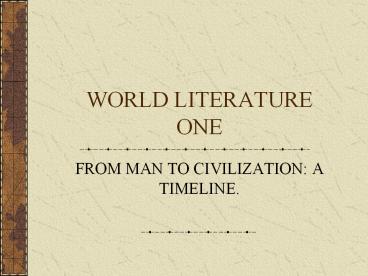WORLD LITERATURE ONE - PowerPoint PPT Presentation
1 / 26
Title:
WORLD LITERATURE ONE
Description:
Mesopotamia: the area between the Tigris-Euphrates Rivers. Present day Iraq ... A rich agricultural region located between the Tigris and Euphrates Rivers. ... – PowerPoint PPT presentation
Number of Views:261
Avg rating:3.0/5.0
Title: WORLD LITERATURE ONE
1
WORLD LITERATURE ONE
- FROM MAN TO CIVILIZATION A TIMELINE.
2
Homo habilis2.2 to 1.6 million years ago.This
species made tools.
3
Homo erectusleft Africa one million years ago.
4
Homo sapiensfirst emerged in Africa 500,000
years ago.
5
Homo sapiens neandethalensisa regional variety
of Homo sapiens arose about 100,000 years ago in
Europe and western Asia.
6
45,000-40,000 years agoHomo sapiens sapiens
first moves out of Africa into southwestern Asia
and Europe.
7
20,000 years ago Human habitation begins in the
Francthi cave in southeastern Greece.
8
10,000-8,000 B.C.Transition from Paleolithic to
Neolithic Age the beginning of agriculture and
permanent settlements.
9
8,000 B.C.Walled settlement at Jericho in
ancient Palestine Catal Huyuk (Turkey) founded
more than 8,000 years ago thriving community for
1000 years.
10
7,000-6,000 B.C.Agriculture and domestication
of animals under way in southern and eastern
Europe, including Greece.
11
7,000-5,000 B.C.Settlements of permanent houses
being built in fertile plains in Greece.
12
3500 B.C.The Sumerians, the first civilization
in Mesopotamia, the Fertile Crescent. These
people were not indigenous to the area, but came
from the Indus Valley, 1500 miles away.
13
THE FIRST CIVILIZATIONS
- Mesopotamia the area between the
Tigris-Euphrates Rivers. - Present day Iraq
- This area has been called the Cradle of
Civilization - This is the land of Gilgamesh
14
ABOUT 3500-4000 B.C.
- Sumeria, the worlds first known civilization
- Later civilizations in the valley
- Babylon, near Baghdad, Iraq,
- And, much later Assyria 600-800 B.C.
15
BACKGROUND OF GILGAMESH
- Source
- Ceram, C.W. Gods, Graves, and Scholars. Alfred
Knopf New York, 1978.
16
GILGAMESH, STORY OF THE SUMERIANS, OLDEST KNOWN
CIVILIZATION
- Location-Mesopotamia
- A rich agricultural region located between the
Tigris and Euphrates Rivers. - 2000 B.C. Assyria, to the north-Ninevah, chief
city
- 2000 B.C. Babylonia, to the south-Babylon, chief
city. - Ninevah, Assyria was the pre-eminent city of the
prehistoric world, much like Rome was to Greece.
17
(No Transcript)
18
Paul Emile Botta
- Physician to a rich Arab, in 1841 discovered the
first Assyrian palace.
19
The Gilgamesh tablets were written in Akkadian,
in cuneiform script on clay tablets or stone.
20
Akkadian is a Semitic language that has a
relationship to Hebrew and Arabic and one of the
principal languages of Babylonia and Assyria.
21
EXAMPLE OF AKKADIAN SCRIPT
22
However, the original language of the epic was
Sumerian, the earliest written language in
Mesopotamia and one that has little if any
connection to any other known language.
23
Gilgamesh developed over a period of nearly a
thousand years.
24
Development of Gilgamesh
- The epic developed over a period of nearly a
thousand years. - The Standard Version was found in the ruins of
the great royal library of Assurbanipal, the last
great king of the Assyrian empire. - It was written on 12 hardened clay tablets.
25
Utnapishtims Story of the Flood
- This portion of Gilgamesh was discovered and
published in 1872. - At that time no one suspected that the biblical
story of Noah and the Great Flood was neither
original nor unique. - This Flood story is very much like the one in
Genesis, only far older.
26
Gilgamesh Themes
- Many of the mysteries of the human condition are
explored for the first time in our literature. - The complex and perilous relationship between
gods and mortals.
- The relationship between nature and civilization.
- The depths of friendship.
- The mortality of humans, and
- The immortality of art.






























![Download Book [PDF] Dogs Who Changed the World: 50 dogs who altered history, inspired PowerPoint PPT Presentation](https://s3.amazonaws.com/images.powershow.com/10080269.th0.jpg?_=20240717125)
